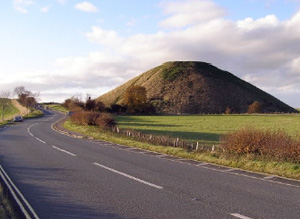Valley containing the River Kennet flowing from Beckhampton to the East through Marlborough and Hungerford towards Newbury, includes the tributary of the Og flowing from the North and joining the Kennet at Marlborough.
The upper reaches of the Kennet valley are dominated by the Late Neolithic and Early Bronze Age monuments which are within the Avebury World Heritage Site including Silbury Hill and the West Kennet Palisade Enclosures. There is also Neolithic evidence at the head of the Lambourn Valley. There is also a notable presence of Roman archaeology; this includes a Roman settlement at the base of Silbury Hill, Roman roads, and the Roman Town at Cunetio (Mildenhall). Traces of early and late Medieval archaeology dominate due to the intense exploitation of the valley resources. Evidence for early Medieval settlement in the valley bottom. Small slivers of open land surviving along the South-Eastern valley edge. These are an important historical survival representing a fraction of the former open pre 1600 land use. These exist alongside surviving areas of 1700 landscapes, and later 1700-1900 relict water meadow landscapes.
North Wessex Downs AONB HLCA Extract 14
Present Day Historic Landscape Character

Large areas of pre 1700 enclosure described above survive in the landscape today. However, in the Og valley and upper reaches of the Kennet reorganised 20th century fields were created.
The water meadows themselves went out of use in the 20th century and were subsequently enclosed. Despite their relict nature the water meadow systems are not entirely destroyed and there are many instances where earthworks of the system (channels and ridges) still survive in the midst of these new fields.
The large areas of designed landscape survive and there are also small slivers of open land surviving along the south-eastern valley edge.
Layers in the Landscape

The upper reaches of the valley are dominated by the Late Neolithic and Early Bronze Age monuments which are within the Avebury World Heritage Site. This includes the major Neolithic mound at Silbury Hill, standing 31 metres high, the West Kennet palisaded enclosure, sub-circular enclosures which cross the current course of the River and the Sanctuary, an excavated timber circle at the end of the West Kennet Avenue.
There is a notable presence of Roman archaeology; this includes a Roman settlement at the base of Silbury Hill, Roman roads, and the Roman Town at Cunetio (Mildenhall). The town lies at the point where at least six main Roman roads converge to cross the River Kennet. The town plan has been revealed by evidence from aerial photographs and consists of a street system with several stone buildings identifiable, including a large complex surrounding a courtyard within the centre of the settlement. The town was enclosed by two phases of defences, with stone defences replacing the earlier phase in the 4th century. There is also a high status Roman villa at Littlecote. This was first discovered in 1730 when the Orpheus Mosaic and a coin hoard, supposedly containing coins of Vespasian (AD 69-79), was found. The site was rediscovered and excavated from 1978. These sites are related to the extensive Roman field systems and settlements on the downland to the North.
The rest of valley is dominated by early and late Medieval archaeology due to the intense exploitation of the valley resources. This includes traces of Medieval settlements which in fills the existing settlement pattern for example at Littlcote, a Medieval hunting lodge and deer park again at Littlecote and also at Ramsbury. Both Marlborough and Overton have known Saxon origins. Marlborough was an important Medieval settlement with a motte and bailey castle established on the pre-existing Marlborough mound, and the town was granted a charter in 1204. A small priory was also established to the South of the town and was excavated in the 20th century. Post Medieval archaeology is dominated by the relict water meadows which were established all along the river bottom.
Historic Settlement Character

This is a mixed area of both nucleated and nucleated regular row Medieval valley floor settlements punctuated by the Medieval planned town of Marlborough. Here the houses were arranged along the main road with regular Burbage plots in behind. These settlements are infilled by small farms and hamlets along the length of the valley.
Historic Farmstead Character
Historic farmsteads were arranged on the edge of historic settlements and hamlets. There is a low-medium concentration of pre-1750 farmstead buildings. These farmsteads are often large with loose courtyard plans or 19th century regular courtyard plans and are associated with the valley bottom.



